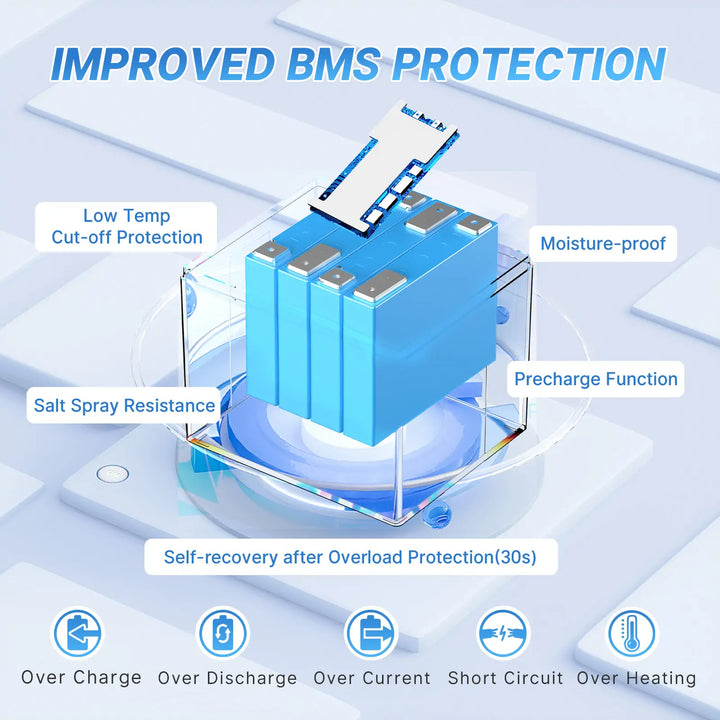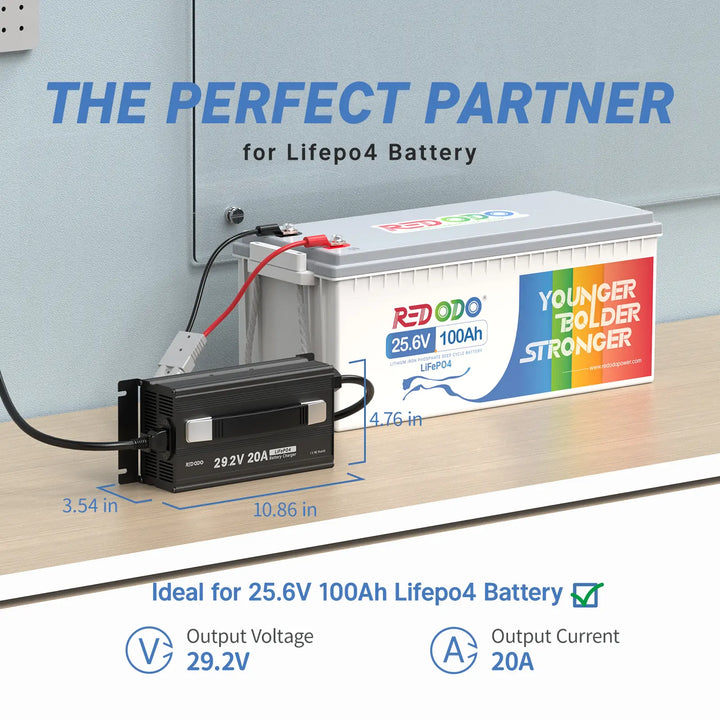Understanding how to connect batteries in series and parallel is crucial for maximizing the performance and efficiency of your battery systems. If you’re new to batteries system, you may want to know how to connect your batteries in series and parallel, even in series-parallel setup. Let’s explore the answer in this blog.
Table of Content
- Series, Parallel, and Series-Parallel Connections
- Connecting Batteries in Series
- How to Connect Batteries in Series?
- Connecting Batteries in Parallel
- How to Connect Batteries in Parallel?
- Series-Parallel Connected Batteries
- Can I Charging Batteries in Series or Parallel?
- FAQs on Series vs Parallel Batteries
Series, Parallel, and Series-Parallel Connections
When you need more power, you can construct a battery bank using widely available batteries. For instance, a common group-size battery like Group 24 battery and Group 31 battery. They are affordable power source for your RV, camper, trailer, and boat.
However, you may be limited by the size of your battery group. Don’t worry, you have a better solution, that is connecting two or more batteries together in series and parallel. By connecting batteries in either series, parallel, or series-parallel, you can increase the voltage, amp-hour capacity, or even both — enabling higher voltage applications or power-hungry equipment to run more efficiently.
Connecting Batteries in Series
Connecting batteries in series is a method used to increase the total voltage of your battery system while keeping the capacity (amp-hour rating) the same as a single battery. This setup is commonly used in applications where higher voltage is required, such as in electric vehicles, solar power systems, and certain industrial equipment.

Example:
If you connect four 12V 100Ah batteries, you’ll have a system with a voltage of 48V and a capacity of 100Ah.
To safely wire batteries in series, all batteries must have the same voltage and capacity ratings. For instance, you can connect two 6V 10Ah batteries in series, but you should not connect a 6V 10Ah battery with a 12V 20Ah battery.
How to Connect Batteries in Series?
Here are the step-by-step to connect batteries in series:
- Ensure Battery Compatibility:
- Before you begin, make sure that all the batteries you intend to connect in series are from the same brand, and have the same type, voltage, and capacity ratings. For example, if you are using 12V 100Ah batteries, all the batteries should have identical specifications. Mixing batteries with different types, voltages or capacities can lead to imbalance issues, potential damage, or reduced efficiency.
- Position the Batteries:
- Arrange the batteries in a neat and accessible layout. This setup will make it easier to connect them and ensure a secure installation. Ideally, the batteries should be placed close together to minimize the length of the connecting cables, which can reduce resistance and potential power loss.
- Connect the Batteries in Series:
- Start by connecting the positive terminal (+) of the first battery to the negative terminal (–) of the second battery using a suitable gauge cable or wire. The gauge of the wire should be appropriate for the current the system will carry—thicker wires are required for higher currents to prevent overheating and energy loss.
- If you are connecting more than two batteries, continue this process by connecting the positive terminal of the second battery to the negative terminal of the third battery, and so on, until all batteries are connected in a single chain.
- Final Connections to Your Equipment:
- After connecting all the batteries in series, you’ll have two free terminals—one positive and one negative. The free positive terminal will be on the first battery in the series, and the free negative terminal will be on the last battery in the series.
- Connect a cable from the free positive terminal to the positive output of your equipment or device, and another cable from the free negative terminal to the negative output. This will deliver the combined voltage of all the batteries to your equipment.
Connecting Batteries in Parallel
When you connect batteries in parallel, you increase the amp-hour capacity of your system, while keeping the voltage the same. Batteries in parallel connections are commonly used in off-grid solar batteries systems, RVs, and marine applications where more energy storage is needed without increasing the voltage.

Example:
Connecting four 12V 100Ah batteries in parallel will result in a 12V 400Ah battery system.
In a parallel connection, batteries must have the same type, capacity, and voltage, and from the same brand.
How to Connect Batteries in Parallel?
Connect the negative terminals of all batteries together. Then, connect the positive terminals of all batteries together. Here are the steps to connect batteries in parallel:
- Prepare the Batteries:
- Ensure that all batteries you plan to connect in parallel have the same voltage rating. For example, if you’re using 12V batteries, all batteries in the parallel configuration should be 12V.
- Ideally, use batteries with the same capacity (Ah rating) to ensure balanced performance. If the capacities differ, the batteries with higher capacity may bear a larger load, leading to uneven wear.
- Position the Batteries:
- Place the batteries next to each other, ensuring easy access to their terminals. This helps in making secure connections and reduces the risk of short circuits.
- Connect the Negative Terminals Together:
- Take a suitable gauge wire or battery cable (based on the current your system will carry) and connect the negative terminal of the first battery to the negative terminal of the next battery.
- Continue this process until all the negative terminals of the batteries are connected in a single loop.
- Connect the Positive Terminals Together:
- Next, take another wire or battery cable of the same gauge and connect the positive terminal of the first battery to the positive terminal of the next battery.
- Continue linking the positive terminals in the same manner until all the positive terminals are connected in a loop, similar to how you connected the negative terminals.
- Connect to Your Equipment:
- Use two copper bars (instead of battery terminals) to connect all thepositive and negative output/input cables, ensuring that the input &output currents of each battery are balanced.
- It is not recommended to use one terminal as the total positive or negative output/input of the battery system as the connected terminals may heat upor even melt if the total output/input current of the battery system is too high.
- After verifying the setup, connect the battery bank to your equipment or device.

Read More: Batteries in Series vs Parallel: Which is Better
LiFePO4 Lithium Batteries in Series VS Parallel Connection
Series-Parallel Connected Batteries
In many cases, we want to more capacity and voltage for our battery system. Series-parallel connections combine the benefits of both series and parallel wiring, increasing both voltage and capacity.
Example:
You can connect six 6V 100Ah batteries to create a 12V 300Ah battery system. This is done by configuring three strings of two batteries in series, and then connecting these strings in parallel.
In this setup, multiple sets of batteries are connected in both series and parallel to boost both voltage and capacity.
Can I Charging Batteries in Series or Parallel?
Yes, you can charge batteries that are connected in either series or parallel, but the method varies based on the configuration.
For batteries in series, you need a charger that matches the total system voltage. For example, if you’ve wired two 12V batteries in series to create a 24V system, you’ll need a 24V battery charger. When charging batteries in parallel, the charger should match the voltage of a single battery, as the overall system voltage remains the same.
However, it’s important to ensure that the charging current is appropriate for the combined capacity. In both cases, using a charger with the proper voltage and current rating is essential to avoid damaging the batteries or reducing their lifespan.
FAQs on Series vs Parallel Batteries
How to connect two 12V batteries in Series to create a 24V battery system?
When connecting in series, you increase the voltage while maintaining the same capacity. In parallel, you increase the capacity while keeping the voltage the same. If you want to wire two 12V batteries to create a 24V battery system, just connect one positive on the second battery to one negative on the first battery, then connect the two free terminals to your device or application, which will now receive 24V.
How to connect four 12v batteries to make a 48v battery system?
Similarly, to connect four 12V batteries to create a 48V battery system, you need to connect them in series. Begin by linking the positive terminal of the first battery to the negative terminal of the second battery. Continue this pattern, connecting the positive terminal of the second battery to the negative terminal of the third, and so on. The free positive terminal of the first battery and the free negative terminal of the last battery will then provide 48V.
Can I connect lead-acid batteries in series and parallel?
Yes, you can connect lead-acid batteries in both series and parallel configurations, but it requires careful attention to ensure the batteries are of the same type, age, and capacity. However, it’s crucial to ensure that the batteries are balanced and in good condition to avoid issues like overcharging, undercharging, or imbalance in power distribution.
It is recommended to replace lead-acid batteries to lithium batteries like Redodo LiFePO4 batteries, which have a greater stability and longer lifespan. What’s more, Redodo has equipped with advanced Battery Management Systems (BMS) to help manage batteries effectively in both series and parallel configurations.

Conclusion
Whether you need to increase the voltage or the amp-hour capacity of your battery system, understanding how to connect batteries in series, parallel, or series-parallel is essential. Redodo Lithium batteries provide the flexibility and reliability you need for various applications, ensuring that your power system performs at its best. If you have any questions or need further assistance with your battery setup, don’t hesitate to reach out to us!

Redodo

Redodo
Recent Post

How Long Does a Trolling Motor Battery Last?

Convert RV from Lead-Acid to Lithium Battery: A Complete Guide

How Long Will a 200Ah Battery Run an Air Conditioner?

A Full Review of Redodo 12V 140Ah Group 31 Deep Cycle Battery


![⚡[$220 after Sign-Up] Redodo 12V 100Ah LiFePO4 Lithium Battery | Best Budget | For RV, Solar, Trolling Motor](http://www.redodopower.com/cdn/shop/files/Redodo_12v_100ah_lithium_battery_b9015ddd-64b5-4be2-8c88-392f0bb4ab30.jpg?v=1742973160)


![⚡[$220 after Sign-Up] Redodo 12V 100Ah Group 24 Deep Cycle LiFePO4 Lithium Battery | For Home, RV, Marine](http://www.redodopower.com/cdn/shop/files/Redodo_12V_100Ah_group_24_lithium_battery_6301965d-f6e8-467f-825f-3eec839b3e1f.jpg?v=1744105344)
![⚡[$220 after Sign-Up] Redodo 12V 100Ah Mini Lithium LiFePO4 Battery | Smallest Battery | For RV, Trolling Motor, Solar](http://www.redodopower.com/cdn/shop/files/Redodo12V100AhMiniLiFePO4LithiumBattery.jpg?v=1739959054)
![⚡[$524 after Sign-Up] Redodo 12V 300Ah Lithium LiFePO4 Battery | Replaces 6*12V 100Ah AGM Batteries | RV, Marine, Solar](http://www.redodopower.com/cdn/shop/files/Redodo_12V_300ah_lithium_deep_cycle_battery.png?v=1744797523)
![⚡[$947 after Sign-Up] Redodo 12V 410Ah Lithium LiFePO4 Battery | King of Power | Marine, RV, Solar Home](http://www.redodopower.com/cdn/shop/products/Redodo12V400Ahlithiumbattery-1.jpg?v=1736154087)